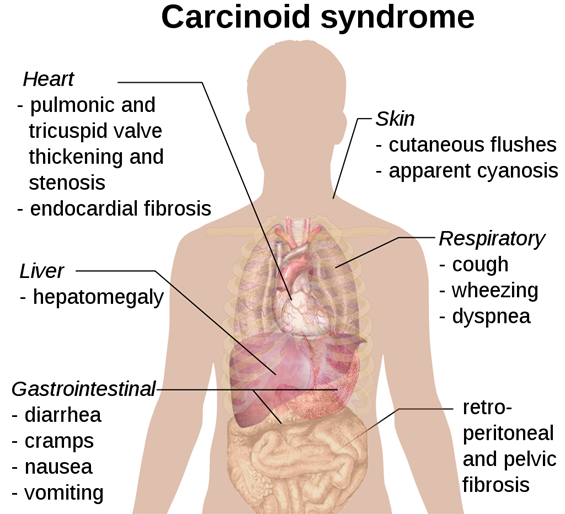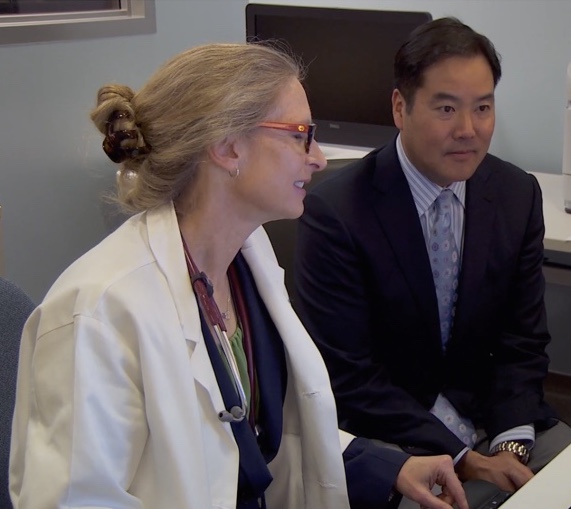Carcinoid Syndrome
Carcinoid tumors are neuroendocrine tumors typically arising in the gastrointestinal (GI) tract, most notably in the ileum, the last third of the small intestine, and the appendix, but may occur elsewhere in the body including the lungs, rectum, colon, pancreas, stomach, ovary, thymus, kidney, prostate, and breast. The term "carcinoid" usually implies a well-differentiated tumor with cells more like normal cells, slower growing, and therefore with less invasive malignant potential.
Carcinoid syndrome is a disease defined by a constellation of symptoms, physical manifestations, and abnormal laboratory findings. Carcinoid syndrome is most often seen in patients who have an underlying (primary) carcinoid tumor arising from the ileum that became advanced, migrated to the lymph nodes, and then spread to the liver where metastatic tumors developed.
About 10% of the people with a carcinoid tumor will develop carcinoid syndrome. Major symptoms include hot, red facial flushing, diarrhea and wheezing. Carcinoid syndrome occurs when the tumor produces excessive amounts of the hormone serotonin in an individual who has liver or ovarian metastases.
In patients without spread to the liver, the serotonin hormones released by the intestinal tumor will be broken down to inactive substances, effectively destroyed. However, if the tumor has spread to the liver, ovaries, or retroperitoneum and liver enzymes can no longer destroy the excess hormones, they accumulate in the body and cause the debilitating symptoms of carcinoid syndrome.
Carcinoid crisis is a life-threatening form of carcinoid syndrome that results where there is an overwhelming release of biologically active compounds such as serotonin from the tumor. This may be triggered by surgical procedures (e.g., biopsy, embolization, liver resection) or anesthesia, and occurs mostly in patients with markedly elevated serum serotonin or urine 5-hydroxyindoleacetic acid (5-HIAA).
Symptoms
- Skin Flushing - The skin on the face and upper chest feels hot and changes color — ranging from pink to purple. Episodes may last between a few minutes to a few hours or longer. Flushing can be triggered by stress, exercise, or alcohol consumption.
- Facial Skin Lesions - Purplish areas of spider-like veins may appear on the nose and upper lip.
- Diarrhea - Frequent and watery stools, sometimes accompanied by abdominal cramps
- Breathing Difficulty - Asthma-like symptoms, such as wheezing and shortness of breath, which may occur with skin flushing.
- Rapid Heartbeat - Periods of increased heart rate.
Presentation of the carcinoid syndrome - - (Own work) [CC0], at Wikimedia Commons
Diagnosis
Symptoms of carcinoid syndrome are frequently mistaken for other diseases, such as Crohn’s disease, ulcerative colitis, or irritable bowel syndrome (IBS). As a result, delayed diagnosis or misdiagnosis frequently occurs. Patients with carcinoid syndrome may often wait 5 to 7 years from the initial onset of their symptoms to receive the correct diagnosis. And 60% to 80% of patients are diagnosed with advanced disease and liver metastases at initial presentation. Diagnosis of carcinoid tumors therefore requires collaboration between specialists across multiple disciplines, including surgery, internal medicine and oncology, gastroenterology, radiation oncology, radiology, endocrinology, endocrine surgery, molecular genetics, clinical immunology, pathology, and nuclear medicine.
Clinicians first seek to rule out other causes of skin flushing and diarrhea. Absent alternative causes, tests are then performed to determine if carcinoid syndrome is the cause including:
- Urine Test - The urine tests looks for excess serotonin, the chemical most commonly excreted by carcinoid tumors.
- Blood Test - The blood test looks for high levels of the protein chromogranin A, as well as other substances, known to be secreted by carcinoid tumors.
- Imaging - Imaging tests including computerized tomography (CT) scan of the abdomen, MRI and nuclear medicine scans (OctreoScan, Ga-68 DOTATOC/DOTATE PET-CT) are used to identify the primary tumor and determine the extent of metastatic spread.
Treatment
Surgery
Surgery may be performed to remove the primary tumor and debulk liver metastases in carefully selected patients after multidisciplinary evaluation. For airway lesions, surgeries such as lobectomy, sleeve resection or pneumonectomy may be performed depending on the size and location of the tumor.
Somatostatin Analog Injections
Somatostatin analog (Sandostatin, Lanreotide) injections may reduce the signs and symptoms of carcinoid syndrome, including skin flushing and diarrhea. Somatostatin analogs are synthetic forms of somatostatin, a pancreatic hormone.
Hepatic Artery Embolization
Embolization is a therapy to treat liver tumors by blocking their blood supply. Because liver tumors thrive on highly oxygenated blood from the hepatic artery, blocking that supply may kill it. Chemoembolization, also known as Transarterial Chemoembolization (TACE), adds the delivery of chemotherapeutic agents to the blockade of the tumor.
Locoregional Therapies
Radiofrequency ablation delivers heat through a needle to the metastatic cells in the liver, causing cell death. Cryotherapy works similarly, but by freezing the tumor. A new technology, microwave ablation (MWA), destroys liver tumors using heat generated by microwave energy.
Chemotherapy
Chemotherapy drugs may shrink neuroendocrine tumors, in particular, those of pancreatic origin. These include temozolomide, fluorouracil, oxaliplatin, and streptozocin-based chemotherapy regimens.
Loco-regional Therapies
Radiofrequency ablation delivers heat through a needle to the cancer cells in the liver, causing the cells to die. Cryotherapy is similar, but it works by freezing the tumor. A newer technology, microwave ablation (MWA), destroys liver tumors by using heat generated by microwave energy.
Other Medications
Anti-diarrheal and anti-cholinergic medications are also used. Patients are advised to avoid alcohol and foods with a high concentration of tyramine, which may worsen symptoms.
References
National Organization for Rare Disorders (NORD) - Carcinoid Syndrome
Mayo Clinic - Carcinoid Syndrome







